
Easy Cauliflower Rice Sushi Rolls
Easy Cauliflower Rice Sushi Rolls: A Low-Carb Japanese-Inspired Recipe
Are you a fan of Japanese cuisine but need to reduce your carbohydrate intake? Whether you’re following a low-carb diet, managing diabetes, or simply looking for healthier alternatives, these cauliflower rice sushi rolls are the perfect way to enjoy the flavors of sushi—without the starch.
This recipe combines the elegance of Japanese cooking with the lightness of vegetables, offering a guilt-free way to satisfy your sushi cravings. In this post, we’ll explore how to make cauliflower sushi rolls at home, the nutritional benefits of their ingredients, and why they’re such a smart addition to a balanced lifestyle.
Falling in Love with Japanese Food
My first contact with Japanese cuisine came through sushi restaurants that began to appear in Spain. At first, I wasn’t fully convinced—the flavors and textures were very different from the Mediterranean food I grew up with.
Over time, though, I started to appreciate the artistry behind sushi and other Japanese dishes. When I traveled to Japan in 2009, I discovered that Japanese cuisine is far more diverse than sushi alone. I tried ramen, okonomiyaki, tonkatsu, and nimono, each with its own story and flavors. That experience opened my eyes to the richness of Japanese food culture.
Still, one challenge remained: the heavy reliance on rice and noodles, both very high in carbohydrates. For people like me, who need to manage blood sugar levels, enjoying these dishes regularly isn’t always the best option. That’s where creativity in the kitchen comes in.
Cauliflower rice sushi rolls provide the flavors of traditional sushi with fewer carbs and calories.
Why Cauliflower Rice Works So Well
Traditional sushi rice is sticky, slightly sweet, and delicious—but it’s also high in starch. For people following a low-carb lifestyle or managing conditions such as type 2 diabetes, rice can quickly raise blood sugar levels.
Cauliflower rice, on the other hand, offers a light and nutritious alternative. Made by pulsing cauliflower florets in a food processor until they resemble grains of rice, it has a neutral taste that pairs perfectly with Japanese flavors.
Nutritionally, cauliflower rice is:
- Low in calories – about 25 calories per cup compared to 200 calories in white rice.
- Low in carbs – only 5 grams per cup, making it suitable for low-carb and keto diets.
- Rich in fiber – which supports digestion and satiety.
- Packed with vitamins – including vitamin C, K, folate, and antioxidants that help reduce inflammation.
With these benefits, it’s easy to see why cauliflower rice has become such a popular substitute in modern cooking.
Nutritional Benefits of the Key Ingredients
Beyond cauliflower, these sushi rolls are made with simple, whole-food ingredients that each bring unique nutritional value.
- Nori (seaweed sheets): Nori is rich in iodine, essential for thyroid function, and provides small amounts of protein, iron, and vitamin B12.
- Avocado: Full of heart-healthy monounsaturated fats, avocado helps support satiety and provides potassium, which regulates blood pressure.
- Cucumber and bell pepper: Both are hydrating, low in calories, and provide antioxidants like vitamin C.
- Smoked salmon or tofu: Salmon adds omega-3 fatty acids that protect heart health, while tofu provides plant-based protein and calcium.
- Soy sauce, wasabi, and pickled ginger: These traditional condiments enhance flavor, though it’s best to choose low-sodium soy sauce and use wasabi sparingly if sensitive to spice.
Together, these ingredients create a balanced meal that combines fiber, protein, and healthy fats while staying low in carbohydrates.
Packed with nutrients and customizable fillings, they are perfect for a healthy, balanced diet.
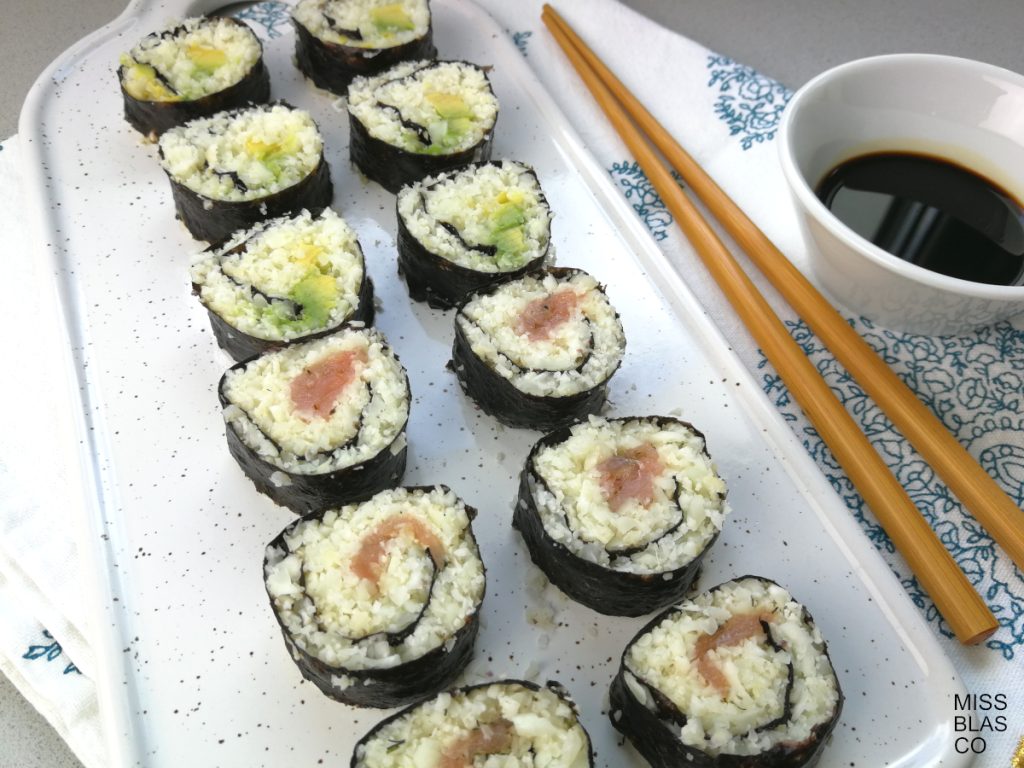
How to Make Cauliflower Rice Sushi Rolls
Making cauliflower sushi rolls at home is easier than it looks. You don’t need special equipment—just a few simple ingredients and a little patience.
Ingredients:
- 1 medium head of cauliflower (processed into rice)
- 1 tbsp rice vinegar
- 1 tsp toasted sesame oil
- A pinch of salt
- Nori sheets
- Fillings of your choice: avocado, cucumber, bell pepper, smoked salmon, or tofu
- Low-sodium soy sauce, wasabi, and pickled ginger for serving
Instructions:
Prepare the cauliflower rice: Pulse cauliflower florets in a food processor until rice-like. Lightly sauté for 5–7 minutes, then season with rice vinegar, sesame oil, and salt. Allow to cool.
- Assemble: Place a sheet of nori on a bamboo mat or clean towel. Spread a thin layer of cauliflower rice evenly across the surface.
- Add fillings: Arrange your vegetables and protein in a line across the center.
- Roll and slice: Roll tightly into a cylinder using the mat, then slice into bite-sized pieces with a sharp knife.
- Serve: Pair with soy sauce, wasabi, and pickled ginger.
This recipe makes about 4–5 rolls, perfect for sharing or storing in the fridge for up to 24 hours.
Does It Taste Like Cauliflower?
One of the most common questions people ask is whether these sushi rolls taste like cauliflower. The answer is no. The flavor of cauliflower rice is very mild, and once combined with the stronger flavors of nori, soy sauce, wasabi, and your chosen fillings, it becomes almost undetectable.
The cauliflower works as a neutral base, just like traditional sushi rice, bringing all the elements together without overpowering the dish.
Easy to make at home, these rolls are budget-friendly and suitable for meal prep.
Why You’ll Love This Recipe
Here are some of the top reasons cauliflower rice sushi rolls deserve a place in your meal plan:
- Low in carbs and calories – suitable for keto, low-carb, and diabetic-friendly diets.
- Rich in nutrients – full of vitamins, minerals, and antioxidants.
- Versatile and customizable – you can create endless variations with different fillings.
- Budget-friendly – made with affordable, widely available ingredients.
- Great for meal prep – prepare in advance for easy, healthy lunches or dinners.
These rolls are a clever way to enjoy sushi while staying aligned with your health goals.
More Cauliflower Recipes You’ll Love
If you enjoy experimenting with cauliflower, try these other recipes:
- Flourless Cauliflower Pizza
- Creamy Cauliflower Soup
- Cauliflower Rice with Vegetables
- Cod and Onion Cauliflower Rice
All are gluten-free, low in carbs, and full of flavor.
Conclusion
Eating well doesn’t have to mean giving up your favorite foods. With a bit of creativity, you can adapt traditional dishes to make them healthier and more suitable for your lifestyle. These cauliflower rice sushi rolls are proof that it’s possible to enjoy Japanese-inspired flavors while keeping your meals light, nutritious, and diabetes-friendly.
Next time you’re craving sushi, give this version a try, it may become one of your new go-to recipes.
Try making this low carb sushi at home and let me know your feedback in the comments section.
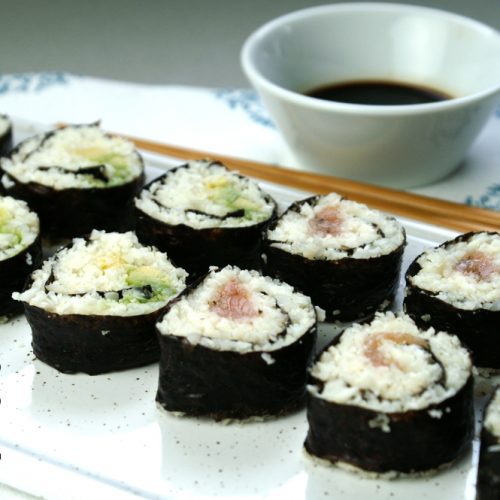
Makis con arroz de coliflor
Ingredients
- 2 hojas de alga nori
- 3 tazas arroz de coliflor (coliflor triturada y cocida al microondas)
- 2 cda vinagre de arroz
- 2 cda agua
- 30 gramos salmón marinado
- 1/4 aguacate
- 3 cda salsa de soja
- 1 pizca sal marina
- 1 pizca wasabi (opcional)
Instructions
- Lo primero que debes hacer es picar la coliflor en crudo. Igual que cuando vas a preparar un arroz de coliflor salteado, pica la coliflor en tu robot de cocina sin que se llegue a formar una pasta, tienen que quedar trocitos pequeños que se noten al masticar.
- Por la coliflor picada en una bandeja apta para microondas y cocina durante 4-5 minutos a máxima potencia. En este caso yo cociné sólo media coliflor, si la cocinas entera deberá estar más tiempo. Es importante que la saques cada 2 minutos y compruebes que va bien. Si al terminar ves que le falta cocción, añades 2 minutos más. Y remueve un poco cada vez que la saques.
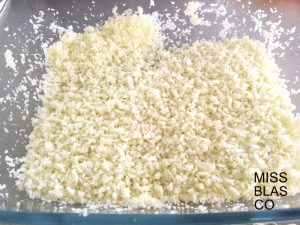
- Una vez cocida, déjala enfriar, en 10 minutos estará a temperatura ambiente. Debe quedar cocida, pero no blanda, debe estar suelta.
- Cuando esté fría, aliña la coliflor con un poco de vinagre de arroz, échalo encima como si aliñaras una ensalada y remueve para que todo el arroz de coliflor se impregne de sabor.
- Puedes añadir una pizca de sal, para mí no es necesario porque la salsa de soja es muy salada y cuando mojes el maki antes de llevártelo a la boca ya le va a aportar el punto salado que necesita.
- Prepara tu esterilla de bambú para hacer los makis, pon encima una hoja de alga nori, recuerda, la cara rugosa hacia arriba, extiende el arroz de coliflor sobre el alga, coge un puñadito, ponlo en el centro y ve aplastando con las manos, reparte por toda la superficie. Deja unos 3 cm libres en la parte superior, será la franja que se pegará al enrollarlo.
Para hacer esto mójate las manos con una mezcla de agua y vinagre de arroz, así no se te pegará tanto.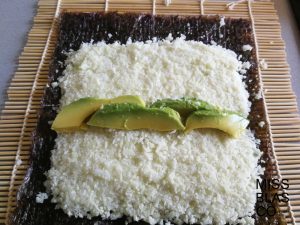
- Pon en el centro el relleno que más te guste, aguacate cortado en tiras, palitos finos de zanahoria, pepino, salmón marinado, atún fresco, gambas, hay muchas opciones. (A mi el surimi no me parece una opción porque debo decirte que no es comida, es un producto ultraprocesado industrial, por eso no lo nombro).
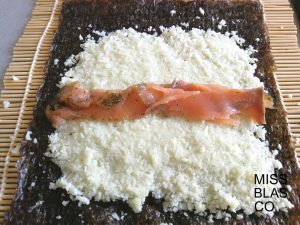
- Haz el rollito ayudándote de la esterilla, aprieta bien y procura que te quede uniforme. Si al ir a cerrar el rollito, hay arroz de coliflor sobrante en el extremo, retíralo, y con los dedos mojados en la mezcla de agua y vinagre, moja el borde y cierra el rollo, quedará perfectamente pegado.
- Deja reposar los rollitos entre 5 y 10 minutos en la nevera, para que cojan un poco más de consistencia y córtalos en trocitos más o menos iguales, de 1 cm o de 1 cm y medio. Si tus cuchillos no son como los cuchillos japones súper afilados, usa un cuchillo que tenga sierra, y haz un movimiento continuo al cortar, ¡nunca presiones hacia abajo, puedes destrozar el rollito, no lo aplastes!
- Coloca tus makis en una bandeja bonita, pon salsa de soja en un pequeño recipiente, y si eres fan del jengibre y del wasabi pues sírvelos para acompañar. Saca tus palillos y disfruta, te van a sentar genial, yo los acompañé de un trozo de atún fresco a la pancha, una combinación muy recomendable. ¡Espero que te gusten! 🙂
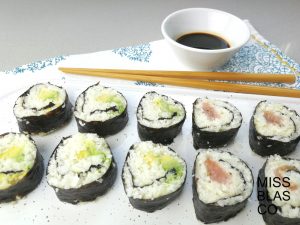
CAULIFLOWER, GLUTEN FREE, LOW CALORIES, LOW CARB, SUGAR FREE, SUSHI
Jose
Espectacularmente sabroso y sorprendente. Muy recomendable.
missblasco
Gracias Jose! 😉